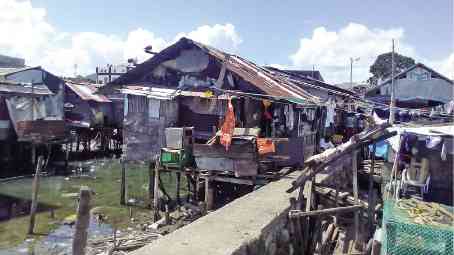
Several families who survived Supertyphoon “Yolanda” (international name: Haiyan) say they will leave their shanties only when water, electricity and livelihood opportunities are ready in resettlement sites. —JOEY GABIETA
TACLOBAN CITY—Juanita Catan is not ready to leave her shanty near the shoreline in Barangay 56, Magallanes district, here.
Although she and her partner, Danilo, live in what is considered a danger zone, they didn’t want to abandon their makeshift dwelling for a house in a resettlement site for families displaced by Supertyphoon “Yolanda” (international name: Haiyan) in 2013.
Catan was among the more than 12,000 families affected by Yolanda in Tacloban City who were supposed to be relocated by December as ordered by President Duterte.
No water, power supplies
But the families refused to move because the 11 resettlement sites had not been completed and lacked basic amenities like water and power.
“We like to be relocated there but not at this time when the resettlement sites do not have power and water supplies,” she added.
She is also hesitant to leave because their new home is more than 10 kilometers away from the city center.
Danilo is a pedicab driver who earns P150 daily by ferrying passengers around Magallanes district.
“We prefer to live here than in the resettlement site. At least, my husband earns here and this somehow helps sustain our daily needs,” she said.
The coastal areas have been designated as “permanent danger zones” after the storm surge generated by Yolanda killed more than 2,200 people in Tacloban, considered the ground zero of the world’s strongest typhoon to hit land.
The city government has identified 11 relocation sites in the northern part of the city where 14,400 houses would be built.
So far, only 2,500 families have been relocated at Ridge View Park 1 and 2 in Barangay Cabalawan, Villa Diana in Barangay new Kawayan and Villa Sofia in Barangay Tagpuro.
Alicia Murphy, executive director of Urban Poor Associates, which provides assistance to typhoon survivors, said they appreciate the effort of the city government to transfer the families.
Livelihood opportunities
“But our worry is while they will live in their own houses, the resettlement sites lack [important] facilities, like schools or health centers, [and] there are no livelihood opportunities being offered to them,” she said.
“You have a house but you will die of hunger in the relocation sites,” Murphy added.
The group asked the city government to delay the relocation until all facilities are in place.
Councilor Aimee Grafil, chair of the city council’s committee on urban poor and resettlement, said the city government has started installing water and power supplies in the resettlement sites.
The Tacloban government has been rationing water to areas in these resettlement sites already occupied by typhoon survivors.
The city has also partnered with the Technical Education and Skills Development Authority and other nongovernment organizations to give residents livelihood opportunities.